Future of supply chains
Despite the crisis, supply chains are at a major turning point. Many economic, social and technological developments will be responsible for a drastic revolution in the coming years.
Economy
In addition to the economic troubles caused by the deleveraging of the global economy, two other important issues are at stake. In the coming years, prosperity will further redistribute in the world. The BRIC countries will see their prosperity and well-being increase further and claim a greater share of the economic pie. The limited availability of raw materials will not only cause a political but also an economic shift. With the growth of prosperity in the BRIC countries, a counter effect will occur when it comes to outsourcing.
For years, costs were considerations for Western companies to bring their production to mainly Asian countries. With the increase in prosperity in those countries, wage costs will also slowly increase, so that the cost advantage disappears. The trend of insourcing has already been noticeable in the United States in recent years. One of the possible solutions to tackle both problems is to shift the cost of labor to raw material. That does mean that consumer behavior will change when it comes to type and motivation of purchase.
Reverse logistics then becomes an important factor in taking back the raw materials in products. Reprocessing and refurbishing becomes a significant part of purchasing and production decisions. Companies also have to take into account that the lifecycle of products will be shorter, but that through 2nd hand marketing such as ‘Marktplaats’ products will gain an important place in the economy.
Society.
In Western countries, the increasing aging of the European population will play an important role in the further globalization of labor. Despite political resistance to migration movements, this will inevitably be given to countries that want to maintain their prosperity. In addition, there is more competition with emerging economies because they need their people themselves and because the knowledge advantage of the West is slowly disappearing.
Artificial intelligence makes sense. Previously, only ‘simple’ labor was automated. Now it is the turn of the next level [middle segment] for replacement. The brain chip from IBM is already a precursor to this. Together with the increasing robotisation, the function of labor will be completely redefined.
Environment.
Climate change as a result of human actions is now undisputed. It is also clear that this change is also taking place and has an effect on our world. Large global players are already taking steps to make their organization more resilient [risk management] But every organization will have to take into account the increasing unreliability of global chains as a result of climate change.
Energy plays an important role in the fight against climate change. Power generation and consumption has a crucial role to play. [CO2] The traditional fossil fuel industry is clearly losing ground. Only the pace at which is under discussion. The direction to full sustainability is inevitable. Energy-intensive industry will have to take account of changed cost ratios in energy consumption. The transport sector will not see a reduction in the coming years, but rather an increase in transport costs. Switching to a sustainable solution is the only remedy to remain competitive.
consumers
Service logistics are becoming more and more important. The total experience of the customer is becoming increasingly important because customers exchange information quickly via social media. It is therefore important to connect the pre- and post-sales service of your supply chain activities. [including product knowledge and information in-store service, warranty and responsive consumer services] It will lead to micro segmentation because customers want more and more specific service.
Consumers will also shop in a more socially responsible manner. Insight into the way in which labor is handled [Bangladesh clothing], carbon footprint and sustainable processes will become part of the purchasing decision process.
Technology.
The biggest change is the use of Big Data in the management of supply chains from the moment the customer walks past or in the store to the control of remote small production facilities. Large ERP systems are not suitable for this. At most to serve as a financial basis, but applying SaaS solutions, where local customization remains possible, offers the most opportunities. The cloud solutions offer the most opportunity for online information exchange throughout the entire chain.
The use of Big Data will still raise the necessary social debate in the coming years. Customers are willing to share their data, but want to keep a check on it. As a result, consumers are engaging in evasive or misleading behavior at the online level. Many young people have multiple profiles online, taking on a completely different guise. But also politics and the judiciary are not unrepresented as Google recently experienced. [right to be forgotten]
Chain renewal
In summary, there are therefore a number of major changes in the chains. Control will change drastically under the influence of technology. The composition of chains due to global development will change. And the responsiveness of chains will have to be greatly improved. Companies will therefore have to invest in knowledge, technology and communication within the chain.
links:
http://addvise.net/de-retail-wel-voorbereid-op-de-omni-channel-uitdaging/
http://addvise.net/breinchip-oplossing-voor-big-data/
http://addvise.net/big-data-wetenschappelijke-analyse/
http://www.logistiek.nl/Supply-Chain/algemeen/2014/10/Nieuwe-keten-Triple-Con-Supply-Chain-1617618W/
http://www.logistiek.nl/Warehousing/magazijninrichting/2014/10/Robotisering-straks-9-van-de-10-dcs-onbruikbaar-1619619W/
http://www.logistiek.nl/social/supply_chain_management/vragen/627
http://www.rwsleefomgeving.nl/publish/pages/94319/naic_2006-2010_1_1.pdf
http://www.retailnews.nl/nieuws/HuUT84T7EeOSgiIACiAWJg-0/kringloopwinkels-zien-omzet-stijgen.html









